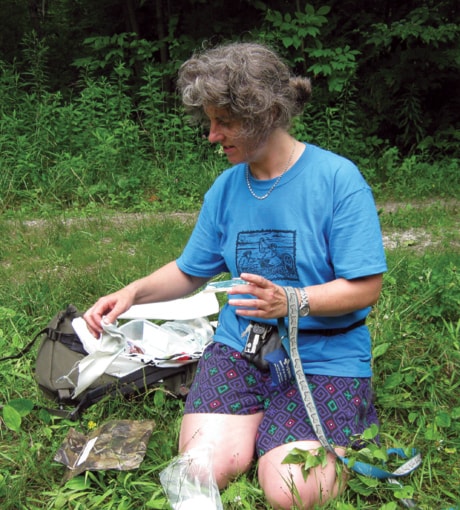TORONTO Ingrid Schmelter was 40 years old when she found her first letterbox by accident while walking her dog Dynamo in a forest.
They’d arrived at a pond and Schmelter was sitting in the grass watching Dynamo play when something caught her eye — a corner of red plastic, sticking up from an old stump.
It was a peanut butter jar with a red plastic lid. Inside was a log book filled with colourful impressions of hand-carved stamps from those who had found the jar before her.
“It was like a magical moment. I was 40 years old and thinking, ‘Wow, there’s something new in the world,”’ says Schmelter, an artist in Stouffville, Ont., northeast of Toronto.
“It was like finding out that fairies exist.”
The people before her who had stamped the logbook in the jar hadn’t stumbled upon it by happenstance. They were letterboxers, members of a secret society that combines sleuthing and the art of printmaking in a hobby that has undercover adherents worldwide.
The premise is simple and anyone can join. You need an ink pad and a rubber stamp — a personal, hand-carved stamp is preferred. They can be made at home with an ordinary pencil eraser and an inexpensive Speedball linoleum carving tool with multiple tips, available at arts and crafts stores.
The clues are available online at www.letterboxing.org, which lists 472 locations in Canada, including 20 in Toronto. Participants go by “trail names” they make up themselves, like Fiddleheads, Trailfeathers, Toadstool, Gwynlais and A Grasshopper.
Unlike geocaching, a high-tech type of hide-and-seek, participants don’t need a GPS device or even a compass to participate. Sometimes clues are hidden in a story, as in “A House in the Hand is worth Two in the Bush,” a tale about a young Toronto couple who bought a semi-detached home, only to see the other half blown up in a propane gas explosion.
Other clues are straightforward, using just a few instructions to get you to letterboxes near the CN Tower or the Zoo at High Park.
The letterboxes themselves contain a hand-carved stamp — typically one that captures the unique character of the location — and a small log book.
Once you find the letterbox, you stamp the logbook with your own stamp, write in the date and your trail name, and then use the stamp in the letterbox to stamp your personal logbook.
“Some do get damaged, lost or disappear,” says Schmelter.
“But people are really good about looking after them. It’s a very co-operative, everybody-wins sport.”
There are rules, of course: Do not dig, remove vegetation, disturb natural rock formations or interfere with animals.
Letterboxes in urban areas have special challenges. There’s an art to hiding them well enough that casual passersby don’t take them. It’s also important to make sure they don’t look suspicious — letterboxes in urban centres have occasionally been mistaken for bombs, triggering a police response.
Now, urban letterboxes are often just a stamp and a log book fixed discreetly to a pole or a box where they can’t be mistaken for a pipe bomb.
Valerie Smith letterboxes with her husband and three children, aged 4, 7 and 10. They’ve made 115 letterboxes over the past four years, scattered around Toronto and their hometown of Guelph, Ont.
She replaced one in Toronto’s Union Station twice before giving up on the location.
“You really have to know what you’re doing to make a letterbox in the city,” says Smith. She knows of an especially clever one in Toronto’s downtown Queen Street West area.
Her greatest letterboxing adventure was a 10-hour blitz of the Niagara Escarpment on the Bruce Peninsula. She and her seven-year-old daughter picked up 15 letterbox stamps that day. Their favourite letterbox is in New York State, behind a waterfall.
Smith likes to create letterboxes to lead other people to great locations.
“It’s a creative and intellectual exercise,” she says. “My most detailed stamp took over 30 hours to carve. It’s a great leap of faith to leave that stamp out in the wild.”
According to “The Letterboxer’s Companion” by Randy Hall, the practice began in 1854 on the moors of Dartmoor in Devon, England, when a hiker left his calling card in a jar in a remote location, with a note asking others to do the same.
That may be true. But the human impulse to leave a mark and connect with others is universal and ageless, and apparently begins young.
“When I was little, I used to drive my mom crazy. Everywhere we’d go, I would want a souvenir. It was complete junk and I know she hated buying them for me ... in the end I don’t have a single one of those trinkets left,” says Schmelter.
“Now I get to have souvenirs of wherever I go and it’s not junk, it fits in a log book. It also doesn’t cost you anything.”
